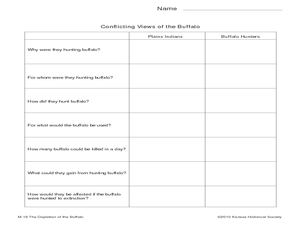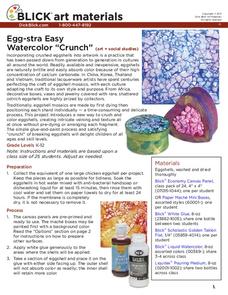Curated OER
Birthday Party
Students help plan a party for Q-Bear and think about some of the different ways people celebrate their birthdays. They then demonstrate knowledge and understanding of customs and traditions associated with participation in cultural...
Curated OER
Touring the World With Tomie dePaola
Students listen aloud to books by Tomie dePaola. They utilize the Internet to study the geography and culture of the places the they read about in Tomie dePaola's books. They answer questions about Norway through an Internet treasure hunt.
Curated OER
Multicultural Sun, Moon, and Star Activities
Students research the multicultural stories and artistic representations of the Sun, Moon, and stars. In this multicultural space lesson, students discuss the symbols and stories for the sun in various cultures. Students construct a...
Curated OER
The Depletion of the Buffalo
Seventh graders consider different cultural viewpoints. In this Kansas history lesson plan, 7th graders examine the depletion of buffalo as a contention point between Native American and European settlers. Students read diary entries to...
Curated OER
Review of Adjectives
The easiest way to learn how to use adjectives is through practice, practice, practice! Print out pictures of people and various objects, and have pairs attempt to describe the items together. This plan suggests providing laminated index...
Dick Blick Art Materials
Egg-Stra Easy Watercolor “Crunch”
It doesn't have to be Easter to enjoy this egg-stra fun art project. Kids crunch egg shells, saturate them with color, and glue them to boxes or other objects to make egg-stra special gifts.
Curated OER
Dig It Up
Students participate in an archaeological excavation to determine how archeologists make inferences about various cultures. They reconstruct the site using layers of drawings. They discuss the kinds of information they learned.
Curated OER
Too Bright at Night?
Learners explore the consequences of light pollution. They consider benefits and drawbacks of technology in order to acquire informed attitudes on the various technologies and their social, cultural, economic, and ecological consequences. .
Curated OER
Math is Beautiful
Students explore how geometry is used on the composition of artworks by artists from different cultures. This activity is equally suited for a Math or Art classroom at the late-elementary or early-middle school level.
Curated OER
Where's Walden and Why Henry?
Sixth graders understand how Thoreau can serve as both inspiration and model for the investigation of home places. They explore ways to become better observers of natural and cultural history. Students find out how to connect with their...
Curated OER
Catch the Gullah Beat: Rhythm and Percussion
Students explore the Gullah culture. In this social studies lesson, students construct and play instruments similar to those of the Gullah people.
Channel Islands Film
Cache: Lesson Plan 2 - Grades 4-6
Class members will dig this activity that has them trying their hand at recovering artifacts. Groups are assigned a section of a sandbox, carefully uncover the artifacts in their section, and then develop theories about who might...
Asian Art Museum
Defining "Home"
Open-ended dialogue and guiding questions lead children through a discussion about the relationship between physical objects and personal identity. They analyze the work of two contemporary Japanese artists who have use their mediums to...
Curated OER
Layer Cake Archaeology
Excavating cake? Why not! Kids spoon into some layers and artifacts during this tasty hands-on activity. The cake, a simulated archaeological dig, is the object of observation and discussion.
Curated OER
"Water is Life" Global Water Awareness
Students examine and calculate the percentage of potable water remaining on the earth. In this ecology and geography lesson, students brainstorm the main factors affecting water distribution. Students use mathematical problem solving to...
Curated OER
2.0 "Water Is Life" Global Water Awareness Mini-Unit (Grades3-5)
Students study the amount of potable water on the Earth. In this water lesson, students examine the amount of potable water as compared to all the water on the Earth. They discuss why many parts of the world do not have access to good...
Curated OER
New Forms from Old
Students look at historic porcelain objects. In this visual arts instructional activity, students examine how the use of historic objects has changed over time. Students design their own object from paper cups, bowls, plates, and...
Curated OER
Useful or Beautiful Worksheet
In this teaching and learning through objects worksheet, students determine whether they would choose to buy 10 items because they are useful or because they are beautiful based on a beauty /utility scale.
Curated OER
Class Consensus Worksheet
In this teaching and learning through objects learning exercise, students compare and discuss responses to the "Useful or Beautiful" learning exercise, and then rank and record the 12 items listed on this learning exercise with the...
Curated OER
Preservation and the Power of Light
Students identify the effect of light on objects. In this scientific inquiry lesson, students use a chart to write a hypothesis about what will happen when colored construction paper is left in sunlight. Students observe and discuss the...
Curated OER
Didgeridoos
Students explore the Aboriginal culture from Australia and create and play their own didgeridoo using recycled objects.
Curated OER
Designing a Civilization for an Art Room
Young scholars discover the ideas of civilizations by researching Gandhi's philosophies. In this art decoration instructional activity, students investigate Gandhi's opinions on civilizations, community and ethics. Young...
Curated OER
Materials: What's It Made of? Word Maze
In this ESL activity learning exercise, students consider cultural differences and similarities as they read a paragraph and find its text in the word maze.
Curated OER
Transportation
Students read through an advertisement to explain meaning, and then present an advertisement they made to the class. They develop the uses of direct and indirect objects in Spanish























